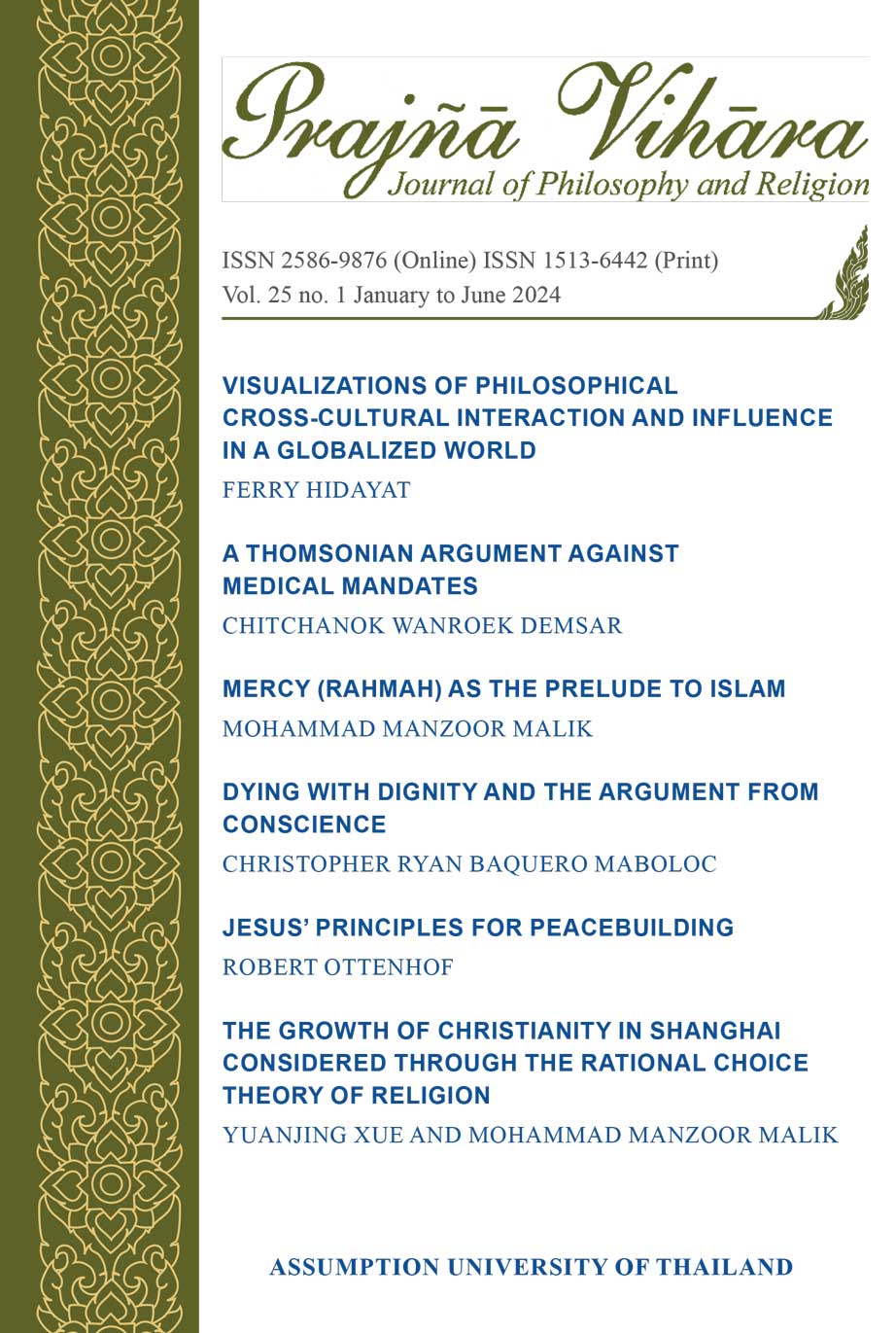THE GROWTH OF CHRISTIANITY IN SHANGHAI CONSIDERED THROUGH THE RATIONAL CHOICE THEORY OF RELIGION
DOI:
https://doi.org/10.59865/prajn.2024.6Keywords:
Christianity; China; Rational Choice Theory of Religion; Marketing of ReligionAbstract
The increasing growth of Christianity in Shanghai, China, provides an instructive model for understanding the marketing and economics of religion. The paper employs theoretical analysis as well as an analysis of the results of field study. The theoretical study employed rational choice theory and the field study included visiting religious places and conducting interviews. The major field work took place at Christian churches and other places of worship in Shanghai city during Christmas and New Year time, 2019. This research concludes that Christianity and its competitiveness in comparison to the other faiths in Shanghai, will gain popularity in Shanghai follower will grow in numbers
References
Amadae, S. (2021, March 11). "Rational Choice Theory." Encyclopedia Britannica. https://www.britannica.com/topic/rational-choice-theory.
Bain, J. S. (2021, September 1). "Monopoly and Competition." Encyclopedia Britannica. https://www.britannica.com/topic/monopoly-economics.
Finke, Roger & Rodney Stark. The Churching of America, 1776-1990: Winners and Losers in Our Religious Economy. New Brunswick, NJ: Rutgers U. Press, 1992.
Finke, Roger & Rodney Stark. Acts of Faith: Explaining the Human Side of Religion. University of California Press, 2000.
Fuller, Andrew R. Psychology and religion: Eight points of view, 3rd ed., Lanham. Littlefield Adams Quality Paperbacks, 1994.
Iannaccone, Laurence R. "Introduction to the Economics of Religion." Journal of Economic Literature. Vol. 36, No. 3 (1998), pp. 1465-1495.
Gordon, Melton, J. Encyclopedia of American Religions. 3rd Edition. Detroit: Gale Research, 1989.
Maslow, Abraham. The Journals of A. H. Maslow. Monterey, CA: Brooks/Cole, 1979.
McCleary, Rachel M. and Rober J. Barro, Robert J. "Religion and Economy." Journal of Economic Perspectives 20, no. 2 (2006): 49-72.
Pew Research Center Forum on Religion and Public Life. 2012. “The Global Religious Landscape.” Retrieved from http://www.pewforum.org/2012/12/18/global-religious-landscape-exec/.
Shanghai Hotline. (2019) “150 Meters Queue and 3 Hours Waiting in front of Shanghai Church at Christmas Eve.” Retrieved from https://hot.online.sh.cn/content/2019-12/25/content_9468510.htm.
Shanghai Municipal Commission of Ethnic and Religious Affairs (2019) Religions in Shanghai. Retrieved from http://mzzj.sh.gov.cn/shzj/index.html.
Smith, Adam. The Wealth of Nations. trans. W. Strahan and T. Cadell, London, 1776.
Stark, R. The Rise of Christianity: A Sociologist Reconsiders History. Princeton University Press, 1996.
Wang, X. (2015). Explaining Christianity in China: why a Foreign Religion has taken root in Unfertile Ground.
Weber, Max. The Protestant Ethic and the Spirit of Capitalism. Scribner, New York, 1958.
Yang, F. (2005) Lost in the Market, Saved at McDonald’s: Conversion to Christianity in Urban China. J. Sci. Study Religion. 44, 423-441.
Ying, F. (2009). The Regional Development of Protestant Christianity in China: 1918, 1949 and 2004. China Rev. 9, 63-97.
Downloads
Published
Issue
Section
License
Consent to Publish and Transfer of Copyright
By publishing in Prajñā Vihāra, the author agrees to transfer and assign to Assumption University of Thailand as the Publisher of the Journal, the copyright to the Article in any form, including any and all rights, interests and claims related to it.
The author does retain the following rights:
- The right to make further copies of the published article for their use in classroom teaching.
- The right to reuse all or part of the published article in a compilation of his or her own works or in textbooks of which they are the author or coauthor.
- The right to make copies of the published article for internal distribution within their academic institution.
- All proprietary rights other than copyright, such as patent rights.
- The Article is his or her original work, and has not been published previously and is not under consideration for publication elsewhere.
- It does not contain any matter that is obscene, libelous, or contrary to law.
- They have obtained the necessary license or written authority and paid any and all related fees for the use and reproduction of text, tables, illustrations and other copyrighted work from the owners of the intellectual property rights, and can furnish the Publisher copies of the license/written authority and proof of payment of related fees upon the signing of this Agreement.
- They have the consent of the Co-Authors of the article upon the signing of this Agreement.
- In the event that they intend to republish, reprint or translate all or part of the Article in other publications, they will secure the prior written permission from the journal Editor.
Prajñā Vihāra adopts the Creative Commons Attribution (CC BY-NC-ND) license





